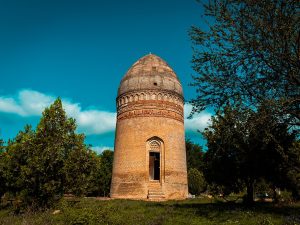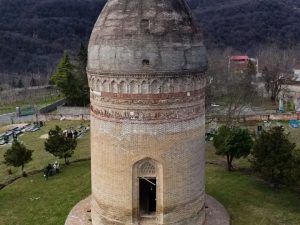Lājim لاجیم
Location: The Lājim tower is in the mountainous region of Mazandaran, northern Iran, Mazandaran Province.
36°15’20.3″N 53°06’21.7″E
Map
Hostorical Period
Islamic
History and description
The Lājim tower, locally known as Emamzad-e -Abdollah, is situated in the southern part of Lājim village in the mountains of Savad Kuh, near Pol-e Sefid, along the road to the Caspian Sea. The monument is built of burnt bricks (fig. 1). Its circumference at the base measures 26.80 meters, and the diameter of the interior room is 5.47 meters. A door, 1.12 meters wide, provides access on the east side. The tower is capped with an elliptical dome (fig. 2). Beneath the dome, two inscriptions—one in Kufic script and the other in Pahlavi—are positioned atop each other. The significance of this structure lies primarily in these inscriptions. These inscriptions are elegantly crafted with carved bricks set against a background of white plaster. The Kufic inscription mentions the name of the building’s patron, Kia Ismail Abolfavares Shahriar ibn Abbas, dated to 413 AH/1022-23 A.D. According to André Godard, the Lājim Tower dates to the same period as the Rādkān West Tower, whose construction began in 407 A.H. (1016-1017 A.D.) and was completed in 411 A.H. (1020-1021 A.D.). The construction of the Lājim Tower was commissioned by rulers of the Bawandid dynasty, who governed this mountainous region south of Sari, their former capital and the site of their leaders’ tombs.
The inscriptions are as follows:
The Arabic inscription reads as follows:
بسم الله الرحمن الرحیم. هذا قبر القیم اکیا الجلیل ابوالفوارس شهریار بن العباس بن شهریار مولا امیرالمومنین رحمه الله امر بینائه فی سنه ثلاث محشر و اربعمانه، عمل الحسن بن علی.
The Middle Persian inscription reads as follows:
This is the dome of Abulfaris Shahryār son of Abbas son of Shahryār. Çihrzād is his mother. An Ādarōg Fire Çihrzād daughter of Silēxūr of [ … ] in the month of Shahriwar [ … ] laid down the foundations of the dome of the powerful king in the year 390, the month of Frawardīn.
Archaeological Exploration
The monument was first brought to attention by two Swiss geologists in the autumn of 1931. Later, in May 1933, André Godard visited Lājim where he photographed the tower and made a sketch plan. Godard recorded and translated the Arabic inscription but could not read the Middle Persian inscription. In 1937, Ernst Herzfeld studied and published the inscriptions but acknowledged that his reading of the Middle Persian text was incomplete. In recent times, Hasan Reza’i Baghbidi published a translation of the Middle Persian text. In 2019, Carlo Cereti published a final translation and detailed commentary, providing a comprehensive analysis. The Arabic inscription was revised and published with commentary by Sheila Blair in 1992.
The Lājim Tower has undergone three major restoration efforts over the years. The first occurred in the late 1970s or early 1980s as an emergency measure following the partial collapse of its dome. During this project, damaged and fallen bricks were removed and replaced with iron bars and cement. Unfortunately, this intervention was carried out without properly considering structural integrity, adding undue weight and pressure to the tower. In 2016, a second restoration focused on the upper section of the tower’s drum, where the inscriptions are located. While the intention was to preserve the inscribed part of the tower, the process led to the displacement of several bricks forming the inscriptions.
Bibliography
Blair, Sh., The Monumental Inscriptions from Early Islamic Iran and Transoxiana, Leiden, 1992, p. 88.
Cereti, C. G., “Two Late Pahlavi Inscriptions from the Alborz Mountains: Lajim and Mil-e Radekan,” in Translation and Transmission: Collection of Articles, edited by JaakkoHämeen-Anttila and Ilkka Lindstedt, Ugarit-Verlag, Münster, 2019, pp. 55-94.
Godard, A., “Les tours de Ladjim et Resget (Mazandaran),” Athār-e Iran, vol. I, Paris, 1936, pp. 109-121.
Herzfeld, E., “Arabische Inschriften aus Iran und Syrien,” Archäologische Mitteilungen aus Iran, vol. 8, 1937, pp. 78-102.
Reza’i Bagbidi, H., “Katibe-ye Pahlavi-kufi-ye borj-e Lājim,” Nāme-ye Iran-e Bāstān, vol. 4/1, 1383/2004, pp. 9-21.
Author: Ali Mousavi
Originally published: November 1, 2024
Last updated: January 11, 2025



































































































































